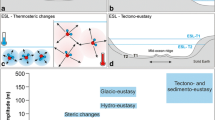Abstract
High-frequency (HF) surface wave radars provide the unique capability to continuously monitor the coastal environment far beyond the range of conventional microwave radars. Bragg-resonant backscattering by ocean waves with half the electromagnetic radar wavelength allows ocean surface currents to be measured at distances up to 200 km. When a tsunami propagates from the deep ocean to shallow water, a specific ocean current signature is generated throughout the water column. Due to the long range of an HF radar, it is possible to detect this current signature at the shelf edge. When the shelf edge is about 100 km in front of the coastline, the radar can detect the tsunami about 45 min before it hits the coast, leaving enough time to issue an early warning. As up to now no HF radar measurements of an approaching tsunami exist, a simulation study has been done to fix parameters like the required spatial resolution or the maximum coherent integration time allowed. The simulation involves several steps, starting with the Hamburg Shelf Ocean Model (HAMSOM) which is used to estimate the tsunami-induced current velocity at 1 km spatial resolution and 1 s time step. This ocean current signal is then superimposed to modelled and measured HF radar backscatter signals using a new modulation technique. After applying conventional HF radar signal processing techniques, the surface current maps contain the rapidly changing tsunami-induced current features, which can be compared to the HAMSOM data. The specific radial tsunami current signatures can clearly be observed in these maps, if appropriate spatial and temporal resolution is used. Based on the entropy of the ocean current maps, a tsunami detection algorithm is described which can be used to issue an automated tsunami warning message.
















Similar content being viewed by others
Notes
Practical salinity unit: 1 psu is equivalent to 1 g of salt per liter of water.
References
Backhaus JO (1985) A three-dimensional model for the simulation of shelf sea dynamics. Dt Hydrogr Z 38:165–187
Barrick D (1972) First-order theory and analysis of MF/HF/VHF scatter from the sea. IEEE Trans Antennas Propag AP-20:2–10
Barrick D (1979) A coastal radar system for tsunami warning. Remote Sens Environ 8:353–358
Bilham R, Engdahl R, Feldl N, and Satyabala SP (2005) Partial and complete rupture of the Indo-Andaman plate boundary 1847–2004. Seismol Res Lett 76(3):299–311
Crombie DD (1955) Doppler spectrum of sea echo at 13.56 Mc/s. Nature 175:681–682
Dzvonkovskaya A, Gurgel KW, Rohling H, Schlick T (2008) Low power high frequency surface wave radar application for ship detection and tracking. Proc. Radar 2008 Conf. Adelaide, Australia, pp 654–659
Dzvonkovskaya A, Gurgel KW, Pohlmann T, Schlick T, Xu J (2009a) Simulation of tsunami signatures in ocean surface current maps measured by HF radar. Proc. Oceans 2009 Conf. Bremen, Germany
Dzvonkovskaya A, Gurgel KW, Pohlmann T, Schlick T, Xu J (2009b) Tsunami detection using HF radar WERA: a simulation approach. Proc. Radar 2009 Conf. Bordeaux, France
Gill EW (1999) The scattering of high frequency electromagnetic radiation from the ocean surface: an analysis based on bistatic ground wave radar configuration. Ph.D. thesis, Memorial University of Newfoundland, St. John’s, Canada
Gill EW, Walsh J (2001) High-frequency bistatic cross sections of the ocean surface. Radio Sci 36(6):1459–1475
Gurgel KW, Barbin Y, Schlick T (2007) Radio frequency interference suppression techniques in FMCW modulated HF radars. Proc. IEEE/OES Oceans 2007 Europe, Aberdeen, Scotland, UK
Gurgel KW, Essen HH, Kingsley SP (1999a) High-frequency radars: physical limitations and recent developments. Coast Eng 37:201–218
Gurgel KW, Antonishki G, Essen HH, Schlick T (1999b) Wellen Radar (WERA), a new ground-wave based HF radar for ocean remote sensing. Coast Eng 37:219–234
Hasselmann K (1971) Determination of ocean wave spectra from Doppler return from sea surface. Nat Phys Sci 229:16–17
Heron, ML, Prytz A, Heron SF, Helzel T, Schlick T, Greenslade DJM, Schulz E and Skirving WJ (2008) Tsunami observations by coastal ocean radar. Int J Remote Sens 29(21):6347–6359
Lipa B, Nyden B, Ullman DS, Terrill E (2006a) SeaSonde radial velocities: derivation and internal consistency. IEEE Oceanic Eng 31(4):850–861
Lipa B, Barrick D, Bourg J and Nyden B (2006b) HF radar detection of tsunami. J Oceanogr 62:705–716
Pierson W, Moskowitz L (1964) A proposed spectral form for fully developed seas based upon the similarity theory of S.A. Kitaigorodskii. J Geophys Res 69(24):5181–5190
Rohling H (1983) Radar CFAR thresholding in clutter and multiple target situations. IEEE Trans Aerosp Electron Syst AES 19:608–621
United States Government Accountability Office (2010) U.S. Tsunami Preparedness. GAO Report 10-490, April 2010
Wait JR (1962) Electromagnetic waves in stratified media. Pergamon, New York
Acknowledgements
The authors would like to thank EADS and Atlas Elektronik for kindly providing the HF radar data sets acquired at Figueira, Portugal. This work has been supported by the German Ministry of Research and Education (BMBF) within its program “Geotechnologien” under the reference number 03G0659A.
Author information
Authors and Affiliations
Corresponding author
Additional information
Responsible Editor: Aida Alvera-Azcárate
This article is part of the Topical Collection on Multiparametric observation and analysis of the Sea.
Rights and permissions
About this article
Cite this article
Gurgel, KW., Dzvonkovskaya, A., Pohlmann, T. et al. Simulation and detection of tsunami signatures in ocean surface currents measured by HF radar. Ocean Dynamics 61, 1495–1507 (2011). https://doi.org/10.1007/s10236-011-0420-9
Received:
Accepted:
Published:
Issue Date:
DOI: https://doi.org/10.1007/s10236-011-0420-9




